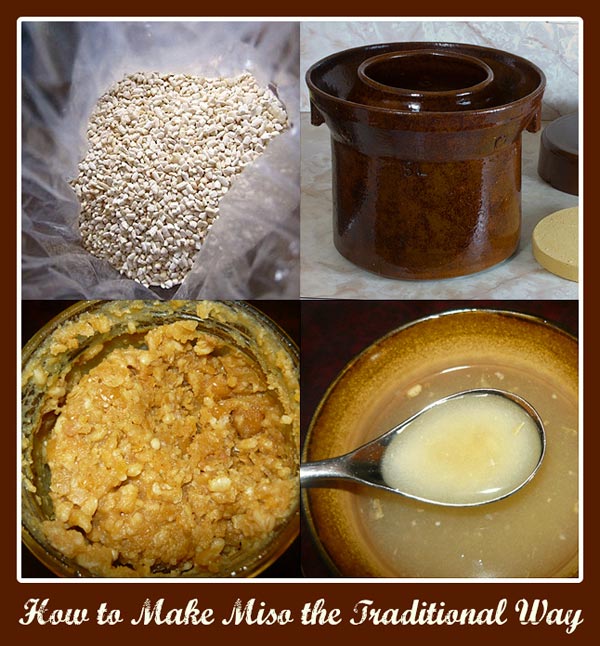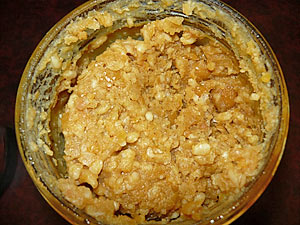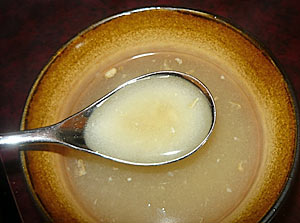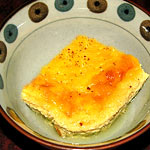
Perhaps the hardest thing about learning how to make miso is simply obtaining all the ingredients and equipment. Soybeans are pretty easy just load up your square foot garden and you are all set. However, if you are like me, you probably fruitlessly looked all over several local health food stores searching for koji. This is the one ingredient you will probably need to order online from a specialty website.
How to make Miso Paste with Koji and What is Koji Anyway?
 Miso is actually a traditional Japanese seasoning produced by fermenting a grain or legume such as rice, barley and or soybeans with salt and koji. The result is a miso paste used for sauces, spreads or mixed in soup stock for making miso soup.
Miso is actually a traditional Japanese seasoning produced by fermenting a grain or legume such as rice, barley and or soybeans with salt and koji. The result is a miso paste used for sauces, spreads or mixed in soup stock for making miso soup.
So what is koji anyway? Basically, koji is rice that has been inoculated, or treated, with Aspergillus Oryzae spores, a special type of mold that breaks starches down into simpler sugars. These starch sugars can then be fermented by yeast, and thus the miso magic begins! And FYI, Aspergillus Oryzae was discovered more than two thousand years ago and has been in use for purposes such as miso making ever since!
How to Make Miso the Traditional Way
To activate the koji, before mixing it with your cooked beans, you will need to mix it with some sea salt. Next, if you are using soybeans, you’re going to want to rinse them and soak them overnight. When learning how to make miso you will discover there are many variations, but one form of white miso I particularly enjoy uses chickpeas instead of soybeans. Chickpeas are one of the most easily digestible beans and the texture is nice and soft.
- You will want to drain the beans after soaking, but then add more water to cook them until they are very soft
- Soybeans may require 3-6 hours of boiling to get them nice and soft
- Drain again, this time reserving some of the mineral rich liquid for later to help create the perfect consistency for your miso paste
- Mash the hot soft beans well (a potato masher works well, but feel free to be creative, some people even use their (clean) feet!)
Making Miso Phase Two
 Then you are going to want to sprinkle the warm mashed beans with sea salt and koji. Make sure the beans aren’t too hot though, you don’t want to deactivate the koji. You can add a little of the reserved cooking liquid to help create your preferred consistency of miso paste – generally you don’t want it too liquidy and you don’t want it too dry.
Then you are going to want to sprinkle the warm mashed beans with sea salt and koji. Make sure the beans aren’t too hot though, you don’t want to deactivate the koji. You can add a little of the reserved cooking liquid to help create your preferred consistency of miso paste – generally you don’t want it too liquidy and you don’t want it too dry.
Your miso paste can then be stuffed into your crock pot (remember, fermenting miso takes many months, so do not put it in the crock you use for everyday cooking!) Also, make sure the crock is clean, some people sterilize it with alcohol or boiling water. One of the best crocks for fermenting is the Harsch crock, a bit pricey but definitely worth it based on the results I get.
Another tip for making miso, if you don’t have a regular crockpot, or even if you do, but just want to make cleanup easier, put the miso paste into a food grade heavy duty plastic bag before putting it into your container or bucket.
You want to put a little bit of sea salt over all the surfaces – put salt on the bottom of the crock, add your miso paste pushing it down and compacting it well to avoid any air pockets which will delay fermentation.
Next, sprinkle the top of your miso with another layer of sea salt to help protect it from unwanted organisms and cover it with plastic (or seal the bag). Then put a weight on top of it. It works well to put a plate over the top and then weigh the plate down with a heavy object such as a big clean rock to keep out excess air and dust.
Where do I Store My Miso Ferment and for How Long?
You’ll need a clean, preferably dark cool place to store your miso ferment where it will be out of the way and undisturbed. Check on it after a month or so and if there is some liquid (like soy sauce) on top of it, give it a good stir, then re-sprinkle with salt on top and leave it alone.
I’ve heard that you only want to mix it up one time because to do so more than that would supposedly reduce the quality because each time you open the bag, air and other organisms may enter.
Let your miso paste ferment for at least six months, or for as long as five years. It will get stronger, more sour and medicinal the longer it ferments. In miso terms, “one year” means it has fermented for one summer. Two years, would be two summers. The oldest miso I have tried so far is 3 year old red miso.
The duration of the ferment determines the type of miso – generally white miso is made with a shorter ferment and red miso is formed as it changes gradually from white to red or black the more it ferments. When stored in a cool place, such as your fridge, miso should not expire.
What are the Health Benefits of Miso
 There are many health benefits associated with eating miso including improved digestion. It is rich in wonderful enzymes and a little goes a long way. Miso is also a good source of many vitamins and minerals including vitamin K which is important for forming blood clots as well as the prevention of bone loss, especially in post-menopausal women.
There are many health benefits associated with eating miso including improved digestion. It is rich in wonderful enzymes and a little goes a long way. Miso is also a good source of many vitamins and minerals including vitamin K which is important for forming blood clots as well as the prevention of bone loss, especially in post-menopausal women.
A typical preparation would be to microwave a cup of water until it is in between warm and hot, but not boiling. Then simply stir in a teaspoon (or more to taste) of your miso paste. Sometimes I like to add a little nori seaweed.
It is also great with tofu, mushrooms, and any number of other variations using vegetables from your garden. Miso can be a quick low calorie digestive aid, or it can be an elaborate meal in itself.
There seem to be as many variations, when it comes to which proportions of the ingredients to use, as there are miso-makers. Learning how to make miso is something of an art, but just to give you a general idea: use 3 lbs soybeans (uncooked), 3 lbs rice koji, and about 1.4 lbs sea salt.
I will probably be modifying that to use 2 pounds of koji rice, 2 pounds chickpeas, and a little less than a pound of sea salt (.92 lbs?….). I may also add some sea vegetables and plan to use spring water. This batch will be a 6 month ferment. When it is done, the white miso is generally stored in the fridge, (a glass jar works well) to halt the fermentation process.
If you are beginning your journey in learning how to make miso we’d love to hear your comments, what has worked for you?

 Earth Friendly Goodies If it's Good for the Earth it's Good for Your Health
Earth Friendly Goodies If it's Good for the Earth it's Good for Your Health 



i didn’t know what was a miso and because of your article i have seen that the miso is a very good ingredient for your health. i went to Google and i can say these ingredient is the best in keeping your weight. for instance i will try the recipe and see if it sweet. 🙂
Hi your miso looks great! Thanks for sharing this wonderful recipe!
Wow, homemade miso, very ambitious! I always have a tub of miso in the fridge and you are making me feel better about how long that tub lasts (years). I do like chickpea miso a lot, that was the last tub we had. Right now we have mellow white soy miso.
Very intersting. It is new information for me. Is the ingredients available in Indonesia or another country. The term of ingredients is still stranger in my hearing.
Oh wow, never knew making some Miso involved a fermenting stage. Thanks for the inside look, very interesting. Some nori with it does sound like the perfect touch.